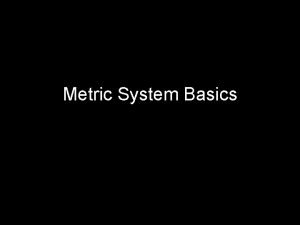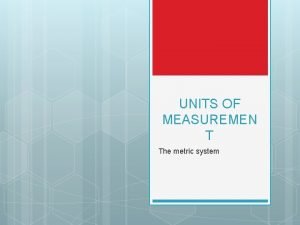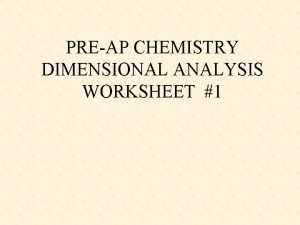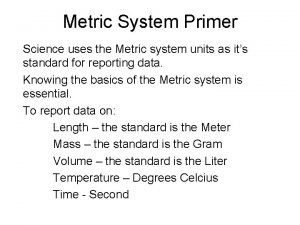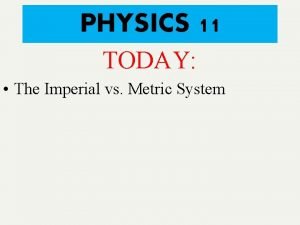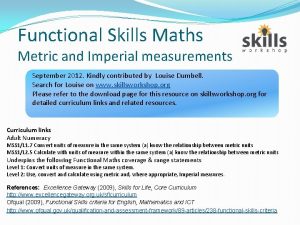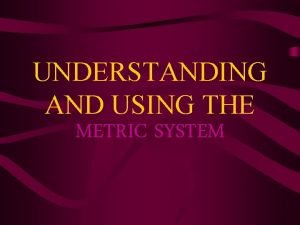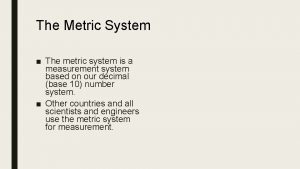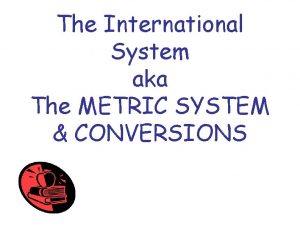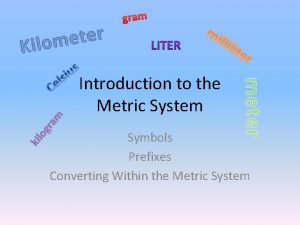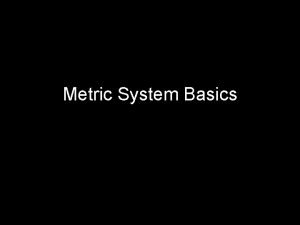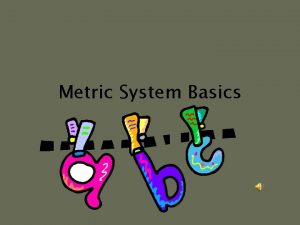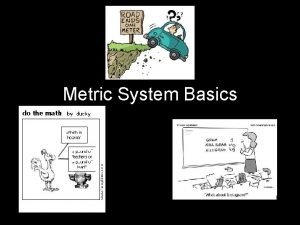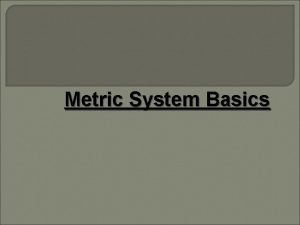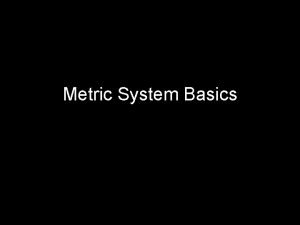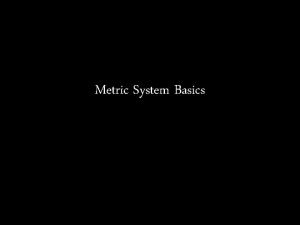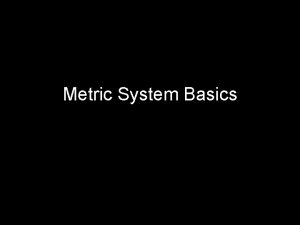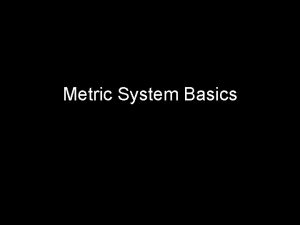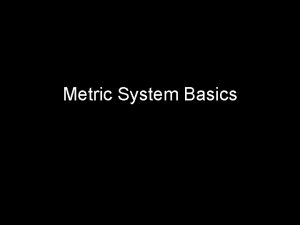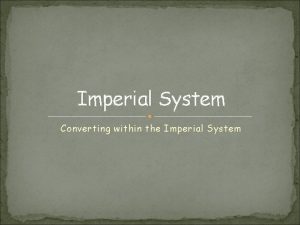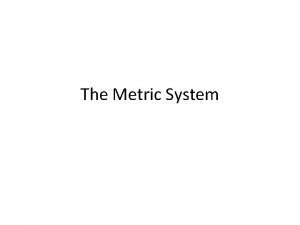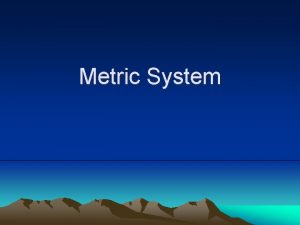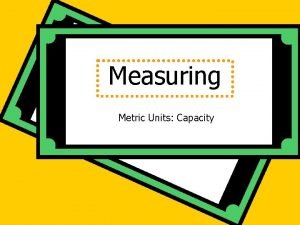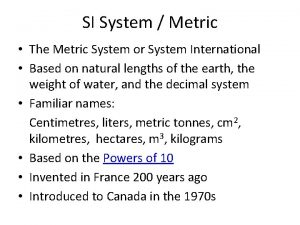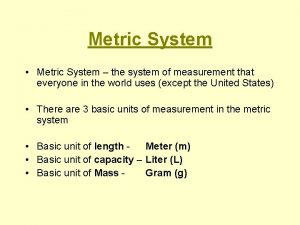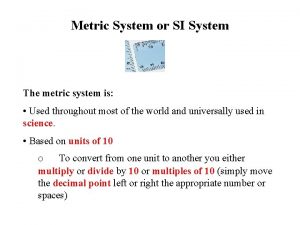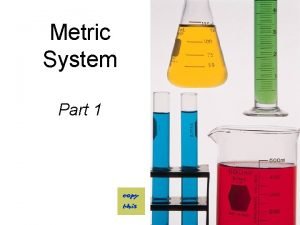Chemistry 11 TODAY The Imperial vs Metric System







































































- Slides: 71

Chemistry 11 TODAY: • The Imperial vs. Metric System

1. 4 Analysis of Units and Conversions in Chemistry Pages: 45 - 58

There are two types of measurements we use Pages: 10 - 20

The units on the following pictures are the IMPERIAL units Copyright © 2010 Ryan P. Murphy

What unit of measurement is this? Copyright © 2010 Ryan P. Murphy

Gallon

What unit of measurement is this? Copyright © 2010 Ryan P. Murphy

Mph (Miles per hour) Gallon

What unit of measurement is this? Copyright © 2010 Ryan P. Murphy

Mph (Miles per hour) Gallon Pounds

What unit of measurement is this? Copyright © 2010 Ryan P. Murphy

Mph (Miles per hour) Gallon Pounds Inches

What unit of measurement is this? Copyright © 2010 Ryan P. Murphy

Mph (Miles per hour) Gallon Pounds Inches Yards

What unit of measurement is this? Copyright © 2010 Ryan P. Murphy

Mph (Miles per hour) Gallon Pounds Inches Yards Fahrenheit

More than likely, we said the following things • Gallon of milk. • 65 miles per hour • Quarter Pounder • 48 inches • Temperature in Fahrenheit Copyright © 2010 Ryan P. Murphy

The countries colored in red are the ones that use the Imperial System Canada (sometimes) The United States Burma Liberia Copyright © 2010 Ryan P. Murphy

The Imperial System Example LENGTH

The IMPERIAL system is based on the following. An inch represents the width of a thumb

Yard the distance from the tip of the nose to the end of the middle finger of the outstretched hand

Foot (12 inches) originally the length of a human foot, although it has evolved to be longer than most peoples feet. Copyright © 2010 Ryan P. Murphy

Mile A Roman unit, originally defined to be the length of 2000 steps of a Roman legion.

The Metric System and SI UNITS Copyright © 2010 Ryan P. Murphy

I will show you these 6 pictures showing you their metric values. Mph (Miles per hour) Gallon Pounds Inches Yards Fahrenheit

One gallon of milk = 3. 78 liters of milk

65 mph = 104 km/h Copyright © 2010 Ryan P. Murphy

Double Quarter Pounder(0. 5 pound) = 0. 226 kg

48 inches tall = 1. 22 meters tall Copyright © 2010 Ryan P. Murphy

1 Yards = 0. 914 meters Copyright © 2010 Ryan P. Murphy

80 degrees Fahrenheit = 26. 7 degrees Celsius Copyright © 2010 Ryan P. Murphy

The International System (System Internationale ‘unites) of Units (SI) also known as THE METRIC SYSTEM.

It is used by scientists all over the world

DIFFICULTY OF THE UNITS One inch IMPERIAL is usually divided into 8, 10 or 16 parts: This particular ruler has 16 divisions

DIFFICULTY OF THE UNITS One inch IMPERIAL is usually divided into 8, 10 or 16 parts: So, the smallest division = 1/16 th of

What is the length of the pencil? One inch is usually divided into 8, 10 or 16 parts: So, the smallest division = 1/16 th of

What is the length of the pencil? One inch is usually divided into 8, 10 or 16 parts:

The simplicity of the Metric System? For example: LENGTH: meter MASS: gram VOLUME: liter Only one unit of measurement for each quantity Copyright © 2010 Ryan P. Murphy

You can measure the very small and the very large with the same unit meter Copyright © 2010 Ryan P. Murphy

The measurements below are all the same. “I am 1828. 80 mm tall. ” 182. 80 cm tall. ” 1. 8280 meters tall. ”. 001828 km tall. ” Compare it with Imperial System Copyright © 2010 Ryan P. Murphy

The simplicity of the Metric System? For example: LENGTH: meter MASS: gram VOLUME: liter SI Only one unit of measurement for each quantity For example: Imperial LENGTH: mile, yard, foot/feet, inch… MASS: grain (≈0. 65 g), drachm (1. 77 g), pound (453 g)… VOLUME: ounce (0. 028 L), gill (0. 142 L), gallon (4. 55 L)… Copyright © 2010 Ryan P. Murphy

Must know! Copyright © 2010 Ryan P. Murphy

MASS

The amount of matter in an object. Copyright © 2010 Ryan P. Murphy

THE BASE UNIT = kilogram SYMBOL = kg

TEMPERATU RE

The degree of hotness or coldness of an object Copyright © 2010 Ryan P. Murphy

THE BASE UNIT = kelvin SYMBOL = K Copyright © 2010 Ryan P. Murphy

TIME Copyright © 2010 Ryan P. Murphy

Time is not the same everywhere. Time speeds up and slows down. The faster you are going, the slower time travels.

THE BASE UNIT = second SYMBOL = s

Amount of Substance Copyright © 2010 Ryan P. Murphy

The mole: The molecular weight of a substance expressed in grams Copyright © 2010 Ryan P. Murphy

THE BASE UNIT = mole SYMBOL = mol

Electric Current Copyright © 2010 Ryan P. Murphy

THE BASE UNIT = ampere SYMBOL = A Copyright © 2010 Ryan P. Murphy

Luminous Intensity Copyright © 2010 Ryan P. Murphy

THE BASE UNIT = candela SYMBOL = cd Copyright © 2010 Ryan P. Murphy

CONVERTING TEMPERATURE The size of the temperature unit (the degree) is the same for KELVIN and CELSIUS scales but different for Copyright © 2010 Ryan P. Murphy

CONVERTING TEMPERATURE However, KELVIN, CELSIUS and FEHRENHEIT scales have different zero Copyright © 2010 Ryan P. Murphy

KELVIN vs. CELSIUS Copyright © 2010 Ryan P. Murphy

CELSIUS vs. Fahrenheit Copyright © 2010 Ryan P. Murphy

Zero Degrees Celsius is a freezing point of water, 100 degrees Celsius is a boiling point of water Copyright © 2010 Ryan P. Murphy

Molecular motion stops at zero degrees K ( -273. 15˚C) Copyright © 2010 Ryan P. Murphy

DENSITY

UNITS gram/cm 3 gram/ml Amount of substance per unit volume of a substance Copyright © 2010 Ryan P. Murphy

Which colored substance will have the lowest density? The more dense, the more heavier something is… Copyright © 2010 Ryan P. Murphy

GREEN SUBSTANCE! The more dense, the more heavier something is… Copyright © 2010 Ryan P. Murphy

The Metric System: A measurement system based on the powers of ten. Copyright © 2010 Ryan P. Murphy

POWERS OF TEN HAVE PREFIXES Copyright © 2010 Ryan P. Murphy

YOU MUST KNOW THEM!!! Copyright © 2010 Ryan P. Murphy
 What is metric and imperial
What is metric and imperial Imperial measurements
Imperial measurements Metric system chemistry
Metric system chemistry Chemistry dimensions 2 worksheet solutions
Chemistry dimensions 2 worksheet solutions Metric mania metric conversions
Metric mania metric conversions For todays meeting
For todays meeting Today class or today's class
Today class or today's class Proposal kickoff meeting agenda
Proposal kickoff meeting agenda Fingerprint galton details
Fingerprint galton details Today's lesson or today lesson
Today's lesson or today lesson Today's lesson or today lesson
Today's lesson or today lesson Metric units chemistry
Metric units chemistry English system of measurements
English system of measurements Metric system vs american system
Metric system vs american system Imperial units physics
Imperial units physics Imperial system
Imperial system Ib chemistry functional groups
Ib chemistry functional groups Inorganic chemistry vs organic chemistry
Inorganic chemistry vs organic chemistry Hát kết hợp bộ gõ cơ thể
Hát kết hợp bộ gõ cơ thể Lp html
Lp html Bổ thể
Bổ thể Tỉ lệ cơ thể trẻ em
Tỉ lệ cơ thể trẻ em Gấu đi như thế nào
Gấu đi như thế nào Glasgow thang điểm
Glasgow thang điểm Chúa yêu trần thế alleluia
Chúa yêu trần thế alleluia Môn thể thao bắt đầu bằng chữ đua
Môn thể thao bắt đầu bằng chữ đua Thế nào là hệ số cao nhất
Thế nào là hệ số cao nhất Các châu lục và đại dương trên thế giới
Các châu lục và đại dương trên thế giới Công của trọng lực
Công của trọng lực Trời xanh đây là của chúng ta thể thơ
Trời xanh đây là của chúng ta thể thơ Mật thư anh em như thể tay chân
Mật thư anh em như thể tay chân Phép trừ bù
Phép trừ bù Phản ứng thế ankan
Phản ứng thế ankan Các châu lục và đại dương trên thế giới
Các châu lục và đại dương trên thế giới Thể thơ truyền thống
Thể thơ truyền thống Quá trình desamine hóa có thể tạo ra
Quá trình desamine hóa có thể tạo ra Một số thể thơ truyền thống
Một số thể thơ truyền thống Cái miệng xinh xinh thế chỉ nói điều hay thôi
Cái miệng xinh xinh thế chỉ nói điều hay thôi Vẽ hình chiếu vuông góc của vật thể sau
Vẽ hình chiếu vuông góc của vật thể sau Nguyên nhân của sự mỏi cơ sinh 8
Nguyên nhân của sự mỏi cơ sinh 8 đặc điểm cơ thể của người tối cổ
đặc điểm cơ thể của người tối cổ Thế nào là giọng cùng tên
Thế nào là giọng cùng tên Vẽ hình chiếu đứng bằng cạnh của vật thể
Vẽ hình chiếu đứng bằng cạnh của vật thể Fecboak
Fecboak Thẻ vin
Thẻ vin đại từ thay thế
đại từ thay thế điện thế nghỉ
điện thế nghỉ Tư thế ngồi viết
Tư thế ngồi viết Diễn thế sinh thái là
Diễn thế sinh thái là Dạng đột biến một nhiễm là
Dạng đột biến một nhiễm là So nguyen to
So nguyen to Tư thế ngồi viết
Tư thế ngồi viết Lời thề hippocrates
Lời thề hippocrates Thiếu nhi thế giới liên hoan
Thiếu nhi thế giới liên hoan ưu thế lai là gì
ưu thế lai là gì Sự nuôi và dạy con của hươu
Sự nuôi và dạy con của hươu Khi nào hổ mẹ dạy hổ con săn mồi
Khi nào hổ mẹ dạy hổ con săn mồi Hệ hô hấp
Hệ hô hấp Từ ngữ thể hiện lòng nhân hậu
Từ ngữ thể hiện lòng nhân hậu Thế nào là mạng điện lắp đặt kiểu nổi
Thế nào là mạng điện lắp đặt kiểu nổi Metric system tools
Metric system tools Advantages of metric system
Advantages of metric system Metric system in america
Metric system in america Metric system
Metric system Base units for metric system
Base units for metric system Metric system chart
Metric system chart Household metric conversion chart
Household metric conversion chart English metric system
English metric system What's the metric system
What's the metric system Milli centi deci chart
Milli centi deci chart Metric system basics
Metric system basics Metric system basics
Metric system basics

